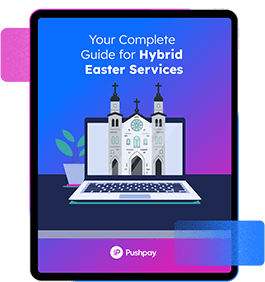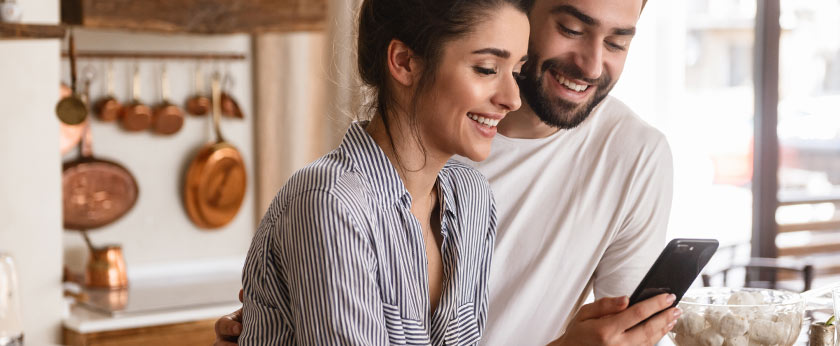5 Tips for Following Up with Digital Church Attendees
Updated September 15, 2023 |
Right now, every church in the U.S. is wrestling with the same problem: how do you replace physical touchpoints with digital touchpoints? When someone attends your weekend service and fills out a contact card, follow-up is easy. But what happens when someone “attends” digitally?
Here are five tips for following up with your digital attendees:
1. Provide digital contact cards
One of the ways your in-person services support your follow-up strategy is by creating natural opportunities to collect contact information. Thankfully, you can still replicate this part of the service digitally.
In your Pushpay church app, you can create branded digital contact cards. You can call them whatever you want and choose how they look, so even though they’re digital, they’ll still be familiar to your congregation. Your custom contact card will appear below your livestream, so you can tell people to fill it out during the service, just like they would in person.
As long as you collect contact information, you should still be able to use a lot of the same follow-up strategies you normally use for in-person services. (House visits are probably off the table for now.)
Without contact information, follow-up is a lot more difficult. But it can be done.
2. Create retargeting ads
Retargeting ads cost money and a little technical know-how. But for churches that can afford to invest in digital outreach, retargeting ads are going to be a must-have communication tool for reaching livestream viewers.
This is one of the only ways to reach people who have only viewed your livestream or other pages on your church website or social media accounts.
How do they work?
You set up a “retargeting pixel” on your website through Google, Facebook, or another advertising platform and set it to track people who view a specific page, such as your livestream. When they leave, the pixel follows them for a specified amount of time, and during this time, you can show ads to these people on Facebook, Google, or other websites they visit.
Ideally, you want your retargeting ads to establish a stronger connection that allows you to communicate with these people in other ways. You might, for example, ask them to give you their email in exchange for a free devotional. Or have them sign up for an online event. You could even have an ad that says something like, “Thanks for joining our livestream. Watch in the [church name] app for an even better experience this weekend.” If nothing else, you can always use retargeting ads to get people to follow your Facebook page or remind them about your upcoming service.
3. Send follow-up emails
Email is one of the best channels you have for follow-up. Not everyone who views your livestream will fill out a contact card, but you can email those who do with a brief “thank you” message that reinforces any applications from your sermon, reminds people when they can join you again, and encourages them to invite others to “attend” next weekend.
Pro tip: You can also follow up with people who don’t fill out contact cards, pointing them to your sermon archives and highlighting some key points from the sermon they may or may not have missed. In a brief P.S., you can say something like, “Did you catch our livestream this weekend? Please fill out a contact card so we know who’s here with us!” Here’s a template email for you to consider:
Subject Line: Your Visit Meant So Much to Us!
Dear [Church Visitor],
We’re so thankful you checked out our church service online! We hope it encouraged you.
Our church’s mission is [church mission]. Information about our worship service can be found on our website (a best practice would be to link a New Visitor page if you have one!).
Your thoughts are greatly valued. Feedback from you would be much appreciated to help us serve better.
Hoping to see you again soon – remember, there’s always a warm welcome here for you!
Warm Regards, [Your Name] Church Leader (be sure to link to your church website and social media)
4. Share live videos
Obviously, live videos on Facebook, Instagram, and other platforms won’t just be visible to people who view the livestream of your service. But this is still a great way to follow up with your digital audience. (Especially if you tell people about it during the service.) When you go live, that video gets prime real estate on your followers’ newsfeeds. So it’s a great way to:
- Remind people of the takeaways from your sermon
- Talk about how church members have been applying your teaching
- Share things you didn’t have time to talk about (or that were too tangential)
- Ask questions related to the topic you’ve been exploring together
- Highlight some of the things your staff has been wrestling with recently
Live videos give your congregation more opportunities to see your staff’s faces, learn from your wisdom, and practice being a digital church.
5. Use push notifications
One of the best ways you can use push notifications right now is to drive people to your livestream when your service starts. But they work well for follow-up after the service as well. After your services are over, that would be a good time to send a notification pointing people to any follow-up items in your app, such as sign-ups for online events and small groups, surveys, or additional content you want people to watch, listen to, or read. You could even remind attendees to fill out your contact cards to give your church more ways to stay in touch.
Leverage digital connections
This is a hard time for a lot of churches. Not just because their communities are in turmoil, but because they’re being pushed to modernize on a very short timeline. But this moment is also a time for churches who understand technology to really shine. Don’t let the lack of physical touchpoints due to COVID-19 hold your church back. Now is a perfect opportunity to experiment with new digital tools, channels, and opportunities.
A Plan to Engage Your Easter Guests
Odds are, you’re so immersed in planning the actual event, that your Easter follow-up isn’t top of mind. To help with this, we’ve created a free ebook to help you give your guests the best experience possible.
The Best
Hybrid Easter

Featured Content
You May Also Like
